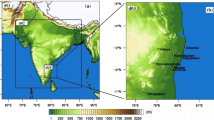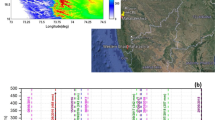Abstract
Observations recorded under the national coordinated STORM (Severe Thunderstorm Observations and regional Modeling) Programme have been used to study the surface parameters associated with tropical squall line (thunderstorm) with trailing stratiform precipitation. A number of studies indicated the presence of three well known features—a pre-squall meso-low, a squall meso-high and a wake low in the surface pressure field associated with a midlatitude squall with trailing stratiform precipitation. In this paper, an attempt is made to identify these mesoscale features, if any, associated with thunderstorms over Indian region. The study is conducted over Kharagpur region, a part of the Gangetic West Bengal frequently affected by thunderstorms during the pre-monsoon season. The observations from 50 m instrumented micro-meteorological tower and upper air sounding at Kharagpur are used in the study. Doppler Weather Radar (DWR) (at Kolkata) imageries are used to identify the squall line with trailing stratiform precipitation. It is observed that in the squall line with trailing stratiform precipitation shield, the meso-high (MH) is associated with convective line and wake low (WL) exists in the rear of the storm. The position of the meso-high is typically found in the vicinity of the heavy rain directly beneath the downdraft.
Access provided by Autonomous University of Puebla. Download conference paper PDF
Similar content being viewed by others
Keywords
These keywords were added by machine and not by the authors. This process is experimental and the keywords may be updated as the learning algorithm improves.
1 Introduction
Mesohigh and wake lows are mesoscale phenomena associated with mid-latitude thunderstorms (Fujita 1955). These result to strong and sometimes severe winds. Johnson (2001) has shown that wake lows typically form during the decaying stage of a mesoscale convective system (MCS) near the rear edge of the trailing stratiform precipitation region. Zipser (1977) has observed that the thermodynamic state of the atmosphere that supports the development of wake low shows “onion” structure in the upper-air sounding.
The Gangetic West Bengal gets frequently affected by thunderstorms known as ‘Noŕwester’ in the summer months (March–May). These weather events are locally called ‘Kalbaisaki’. Severe thunderstorms create great damages to property, crops, human and animal fatalities over small areas through strong surface wind squalls, large hails, frequent lightning and heavy rain showers. They also cause serious aviation hazards. A nationally coordinated program, named Severe Thunderstorm Observation and Regional Modeling (STORM), has been initiated by the Department of Science and Technology (DST) and the Ministry of Earth Sciences of the Government of India, in order to improve the present understanding of the pre-monsoon thunderstorms over the eastern and north-eastern part of India. The objective of this paper is to examine whether the meso-high and wake-low features are also present in the tropical trailing stratiform squall-line thunderstorms and the thermodynamic environment associated with these features.
2 Data
The datasets that have been used in the present study are the 50 m micrometeorological tower observations during the pre-monsoon period (15th April–31st May) under the STORM field experiment in 2007, 2009 and 2010. The upper-air sounding at Kharagpur and the imageries from Kolkata Doppler Weather Radar (DWR) are also utilized in the study. The NCEP/NCAR reanalysis dataset is used to check the prevailing synoptic situation over the region.
3 Analysis
The DWR imageries suggested that 12 squall line thunderstorms affected Kharagpur and adjoining areas during STORM field experiment periods in 2007, 2009 and 2010. The observational datasets mentioned above are analyzed for all the 12 cases. The data analysis of one (5th May 2010 thunderstorm case) of these 12 cases is presented in some detail in this section. The maximum variation in pressure and wind gust associated with the other cases is summarized in Table 1.
3.1 th May 2010
The large-scale circulation during pre-monsoon months is characterized by ascending motion over Indian landmass and descending motion over the surrounding seas. This leads to a shallow inflow of warm moist air from the sea (the Bay of Bengal) along the east coast. Thus the air in the southeastern part of India is moist, whereas, in the northwestern part it is relatively dry and cold. This favors development of thunderstorm activity. This favors development of thunderstorm activity. On 5th May 2010, a trough of low pressure area formed extending from North West India to West Bengal across the Bihar, Jharkhand and Orissa (figure not shown). This trough of low pressure persists up to Jharkhand till 06:00 UTC. The DWR imageries (Fig. 1) show the squall line having a southwest-northeast orientation at 08:25 UTC. The squall-line reached Kharagpur region around 0943 UTC. The structure of the convective line was trailing stratiform type as observed from the DWR imageries.
The passage of this trailing stratiform squall line is illustrated in a time series of surface observations (Fig. 2) obtained from 50 m micrometeorological tower at Kharagpur. The arrival of the convective line over Kharagpur was marked by sudden increase in surface wind speed by 3–4 m/s and in pressure by 5 hPa and is followed by heavy rainfall. The maximum surface pressure was recorded at the time of maximum rainfall intensity. This clearly indicates the passage of a meso-high. The passage of the meso-high is followed by drop in pressure of 7 hPa in 1 h. During this time, the pressure decreased first slowly and then rapidly, reaching a minimum at about 20 min after the rainfall ends. This is a clear indication of wake low. During the process of wake low, the wind direction was slowly changed from northeasterly to south of southeasterly (clockwise). The end of the wake low is characterized by an abrupt increase in pressure (5 hPa) and gradual wind shift [In the process wind gradually veered from south of southeasterly to northeasterly (anticlockwise)]. The convective rainfall continued for about 45 min due to the presence of convective clouds in the front-end of the squall-line. The stratiform cloud let to light stratiform rain for next 2 h.
Radiosonde observations at 06:00 UTC at Kharagpur revealed a large unstable layer above the 900 hPa (Fig. 3). The post-squall upper-air sounding (at 12:00 UTC) at Kharagpur resembles the ‘onion shape’ suggested by Zipser (1969).
4 Summary and Conclusions
The analysis of surface pressure, temperature, relative humidity, winds and rainfall associated with trailing stratiform squall-line thunderstorm at Kharagpur reveals two mesoscale phenomena, namely a meso-high and a wake low. The meso-high was observed during the period of heavy downdrafts. A pressure rise up to 7 hPa was recorded at the time of maximum rainfall. The wake low is found after the completion of heavy rainfall i.e. just behind the convective line. The drop of pressure up to 12 hPa was recorded during the wake low period. It is also observed that the maximum pressure fall was recorded when the stratiform cloud of the squall-line crossed over the station (Kharagpur). This observation agrees well with that of the mid-latitude squall-line, where a meso-high forms near the convective line and a wake low in the rear i.e. within the trailing stratiform region.
The post-squall sounding of Skew-T and log P plot at Kharagpur depicted mid-tropospheric cooling and lower tropospheric warming. Maybe, these are due to the dominance of evaporative cooling in the mid levels and dynamically forced decent leading to adiabatic warming in the low levels. These observations indicate that the trailing stratiform precipitation region of the squall-line thunderstorm provides significant mesoscale weather phenomena in the tropical region, also.
References
Fujita TT (1955) Results of detailed synoptic studies of squall lines. Tellus 7:405–436. doi:10. 1111/j.2153-3490.1955.tb01181.x
Johnson HR (2001) Surface mesohighs and mesolows. Bull Am Meteorol Soc 82:13–32. doi:10. 1175/1520-0477(2001) 082<0013:SMAM>2.3.CO;2
Zipser EJ (1969) The role of organized unsaturated convective downdrafts in the structure and rapid decay of an equatorial disturbance. J Appl Meteorol 8:799–814. doi:10.1175/1520-0450(1969) 008<0799:TROOUC>2.0.CO;2
Zipser EJ (1977) Mesoscale and convective-scale downdrafts as distinct components of squall-line structure. Mon Weather Rev 105:1568–1589. doi:10.1175/1520-0493(1977)105<1568:MACDAD>2.0.CO;2
Acknowledgments
The authors are thankful to the Department of Science and Technology (DST), Govt. of India, for organizing STORM program from which the required data were made available.
Author information
Authors and Affiliations
Corresponding author
Editor information
Editors and Affiliations
Rights and permissions
Copyright information
© 2013 Springer-Verlag Berlin Heidelberg
About this paper
Cite this paper
Dawn, S., Mandal, M. (2013). Surface Meso High and Wake Low Associated with Pre-Monsoon Thunderstorm Over the Kharagpur Region. In: Helmis, C., Nastos, P. (eds) Advances in Meteorology, Climatology and Atmospheric Physics. Springer Atmospheric Sciences. Springer, Berlin, Heidelberg. https://doi.org/10.1007/978-3-642-29172-2_9
Download citation
DOI: https://doi.org/10.1007/978-3-642-29172-2_9
Published:
Publisher Name: Springer, Berlin, Heidelberg
Print ISBN: 978-3-642-29171-5
Online ISBN: 978-3-642-29172-2
eBook Packages: Earth and Environmental ScienceEarth and Environmental Science (R0)







